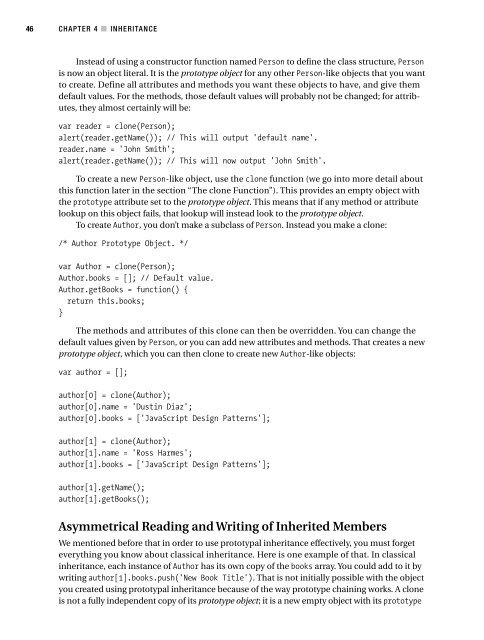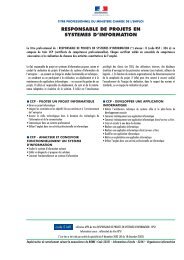Design Patterns
Download - Assembla
Download - Assembla
- No tags were found...
Create successful ePaper yourself
Turn your PDF publications into a flip-book with our unique Google optimized e-Paper software.
46<br />
CHAPTER 4 ■ INHERITANCE<br />
Instead of using a constructor function named Person to define the class structure, Person<br />
is now an object literal. It is the prototype object for any other Person-like objects that you want<br />
to create. Define all attributes and methods you want these objects to have, and give them<br />
default values. For the methods, those default values will probably not be changed; for attributes,<br />
they almost certainly will be:<br />
var reader = clone(Person);<br />
alert(reader.getName()); // This will output 'default name'.<br />
reader.name = 'John Smith';<br />
alert(reader.getName()); // This will now output 'John Smith'.<br />
To create a new Person-like object, use the clone function (we go into more detail about<br />
this function later in the section “The clone Function”). This provides an empty object with<br />
the prototype attribute set to the prototype object. This means that if any method or attribute<br />
lookup on this object fails, that lookup will instead look to the prototype object.<br />
To create Author, you don’t make a subclass of Person. Instead you make a clone:<br />
/* Author Prototype Object. */<br />
var Author = clone(Person);<br />
Author.books = []; // Default value.<br />
Author.getBooks = function() {<br />
return this.books;<br />
}<br />
The methods and attributes of this clone can then be overridden. You can change the<br />
default values given by Person, or you can add new attributes and methods. That creates a new<br />
prototype object, which you can then clone to create new Author-like objects:<br />
var author = [];<br />
author[0] = clone(Author);<br />
author[0].name = 'Dustin Diaz';<br />
author[0].books = ['JavaScript <strong>Design</strong> <strong>Patterns</strong>'];<br />
author[1] = clone(Author);<br />
author[1].name = 'Ross Harmes';<br />
author[1].books = ['JavaScript <strong>Design</strong> <strong>Patterns</strong>'];<br />
author[1].getName();<br />
author[1].getBooks();<br />
Asymmetrical Reading and Writing of Inherited Members<br />
We mentioned before that in order to use prototypal inheritance effectively, you must forget<br />
everything you know about classical inheritance. Here is one example of that. In classical<br />
inheritance, each instance of Author has its own copy of the books array. You could add to it by<br />
writing author[1].books.push('New Book Title'). That is not initially possible with the object<br />
you created using prototypal inheritance because of the way prototype chaining works. A clone<br />
is not a fully independent copy of its prototype object; it is a new empty object with its prototype











